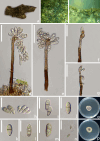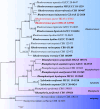Morphological and phylogenetic evaluation of a new species of Rhodoveronaea (Rhamphoriaceae, Rhamphoriales) associated with Quercusfabrei (Fagales) in Yunnan Province, China
- PMID: 40703222
- PMCID: PMC12284583
- DOI: 10.3897/BDJ.13.e154654
Morphological and phylogenetic evaluation of a new species of Rhodoveronaea (Rhamphoriaceae, Rhamphoriales) associated with Quercusfabrei (Fagales) in Yunnan Province, China
Abstract
Background: During an extensive mycological exploration of Fagales-associated mycoflora within the biodiverse landscapes of Yunnan Province, China, we discovered a new saprotrophic fungal species. Based on its unique morphological characteristics and phylogenetic analyses of combined LSU, ITS, SSU, tef1-α and rpb2 sequences, we established Rhodoveronaeaquerci as a new member of the genus Rhodoveronaea, which was collected from Quercusfabrei colonising terrestrial habitats.
New information: Rhodoveronaeaquerci is currently only known from its asexual form, which is a morphologically distinct hyphomycete fungus. The distinguishing characteristics of R.querci are straight or slightly flexuous, septate and unbranched conidiophores, terminally, integrated, apically protuberant, recurved conidiogenous cells with conspicuous conidiogenous loci and ellipsoidal to narrowly-obovoid, mostly 1-septate, slightly constricted at the central septum, guttulate, conidia with a flat basal scar. Rhodoveronaeaquerci and R.hainanensis are highly similar in the size and shape of their conidiophores and conidia, but they can be distinguished by other morphological characteristics and by genetic differences. Rhodoveronaea species are widely distributed in Europe and Asia and recent studies revealed several new Rhodoveronaea species from China.
Keywords: Fagaceae; asexual morph; new species; phylogeny; taxonomy.
Yan-Yan Yang, Chitrabhanu S. Bhunjun, Vinodhini Thiyagaraja, Pattana Kakumyan, Darbhe J. Bhat, Fatima Al-Otibi, Tai-Shun Li, Qi Zhao, Kevin D. Hyde.
Figures



Similar articles
-
Short-Term Memory Impairment.2024 Jun 8. In: StatPearls [Internet]. Treasure Island (FL): StatPearls Publishing; 2025 Jan–. 2024 Jun 8. In: StatPearls [Internet]. Treasure Island (FL): StatPearls Publishing; 2025 Jan–. PMID: 31424720 Free Books & Documents.
-
Taxonomy and phylogeny of Irpicaceae and Meruliaceae (Polyporales, Basidiomycota) with descriptions of four new species from southwestern China.MycoKeys. 2025 Jul 4;119:197-234. doi: 10.3897/mycokeys.119.157018. eCollection 2025. MycoKeys. 2025. PMID: 40656898 Free PMC article.
-
Signs and symptoms to determine if a patient presenting in primary care or hospital outpatient settings has COVID-19.Cochrane Database Syst Rev. 2022 May 20;5(5):CD013665. doi: 10.1002/14651858.CD013665.pub3. Cochrane Database Syst Rev. 2022. PMID: 35593186 Free PMC article.
-
Sexual Harassment and Prevention Training.2024 Mar 29. In: StatPearls [Internet]. Treasure Island (FL): StatPearls Publishing; 2025 Jan–. 2024 Mar 29. In: StatPearls [Internet]. Treasure Island (FL): StatPearls Publishing; 2025 Jan–. PMID: 36508513 Free Books & Documents.
-
A rapid and systematic review of the clinical effectiveness and cost-effectiveness of paclitaxel, docetaxel, gemcitabine and vinorelbine in non-small-cell lung cancer.Health Technol Assess. 2001;5(32):1-195. doi: 10.3310/hta5320. Health Technol Assess. 2001. PMID: 12065068
References
-
- Chaiwan N, Gomdola D, Wang S, Monkai J, Tibpromma S, Doilom M, Wanasinghe D. N., Mortimer P. E., Lumyong S, Hyde K. D. https://gmsmicrofungi.org: an online database providing updated information of microfungi in the Greater Mekong Subregion. Mycosphere. 2021;12(1):1513–1526. doi: 10.5943/mycosphere/12/1/19. - DOI
-
- Chen X. M., Tang X., Du T. Y., Lu Y. Z., Suwannarach N., Xu R. F., Yang E. F., Elgorban A. M., Tibpromma S., Karunarathna S. C. Two new species of Rhodoveronaea (Rhamphoriales, Ascomycota) from terrestrial habitats in China. Phytotaxa. 2024;638(1):49–60. doi: 10.11646/phytotaxa.638.1.4. - DOI
-
- Chethana K. T., Manawasinghe I. S., Hurdeal V. G., Bhunjun C. S., Appadoo M. A., Gentekaki E., Raspé O., Promputtha Itthayakorn, Hyde K. D. What are fungal species and how to delineate them? Fungal Diversity. 2021;109(1):1–25. doi: 10.1007/s13225-021-00483-9. - DOI
LinkOut - more resources
Full Text Sources
